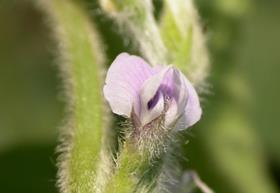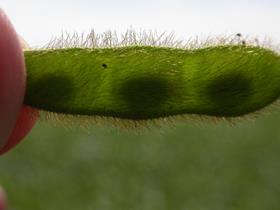Row Spacing – Narrow row spacing is preferable for late-planted or replanted soybeans. The closer spacing of these shorter plants in narrow rows allows for better utilization of sunlight and also helps promote higher positioning of the lowest seed-bearing node.
Plant Population – With normal planting dates, research has shown that soybean populations as low as 90,000 plants per acre can provide near maximum yields. However, with late planting, populations should be increased 10-20 percent above average for each additional week of planting delay. This helps ensure that there is an adequate number of flowering nodes available to produce a respectable yield.
Flowering and Day Length – Flowering in soybeans is triggered by daily hours of darkness. Since nights (at the time of the summer solstice) actually are longer as you go south, moving a variety south from its adapted zone may cause it to bloom earlier. This is why we recommend staying close to adapted maturities, even with late planting or double-crop soybean production. In many cases, with late planting recommendations, a slightly fuller season variety is suggested.
When Flowering Starts – Flowering will normally begin at about the V6 to V10 growth stage but may begin as early as V4. The first blooms are usually noted at the 3rd to 6th stem node.
Stress Effects on Flowering – A period of stress may cause flowering of indeterminate and semi-determinate soybean varieties to slow or stop. On occasion, we have seen these soybeans renew both vegetative and reproductive growth with the return of favorable conditions. Although this demonstrates the adaptability of some of our modern varieties, the presence of both dry beans and “butter beans” on the same plant makes for difficult harvest and often results in lower grain quality.
Duration of Bloom Production – With most soybean varieties adapted to Midwest growing conditions, blooming (that results in viable pods) can occur over 30+ days.
Numbers of Flowers Versus Yield – Some soybean varieties are known to produce enough flowers to theoretically produce 250 bushel yields. While this unrealized yield potential is often a concern of soybean breeders, most recognize that this is simply a useful trait that helps the soybean tolerate periods of stress while maintaining a base reproductive potential.
Most Vulnerable Growth Stage for Defoliation – At the R2 (full bloom) growth stage, insect damage or a hailstorm can be devastating. Fifty percent defoliation at this stage can reduce yields sixty percent.
Seed Size – Seed size is related to planting date, according to Purdue University research. Larger seed is produced with soybeans planted in May and early June. The number of stem nodes is maximized with early planting, and decreases significantly after early May.
Temperature and Seed Set – Soybean seed set is affected by temperature. Seed set is most consistent when warm nights (70O F) are followed by warm days (at least 80O F). Night temperatures of 60O F or less and daytime temperatures of 95O F or above may adversely affect seed set. The ideal temperature for seed development is 86O F.
Maximum Above-Ground Growth – The growth period midway between R5 and R6 is important. This is when the soybean plant reaches its maximum height, has developed the maximum leaf area, has the most stem nodes, and peaks in nitrogen fixation (followed by a rapid decrease in N-fixation). Root growth is complete by about R6 to R7.
Soybean nutrient uptake – Soybeans can respond to a favorable growing environment relatively late into the growing season. They take up most of their needed primary nutrients after flower initiation. The following information is interpreted from the Iowa State University publication “How a Soybean Plant Develops.” This is a summary of how much nitrogen and potassium are assimilated by the soybean plant during the ‘R’ Stages:
Flowering……….10% to 15% of total needs.
Pod Set…………30% to 35% of total needs.
Seed Set………..40% to 45% of total needs.
 |  |
| Soybean Bloom | Soybean Pod at the R5 Growth Stage |